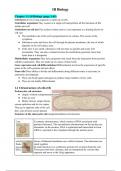Summary
Summary of the entire Biology book from the IB diploma
- Course
- Institution
- Book
This document is the summary which I used to pass the International Baccalaureate biology exam. It is the entire book summarized in just 25 pages, in a didactic manner and with links to the book (each chapter or topic says which page of the book it is on in case you need more information). It also...
[Show more]



